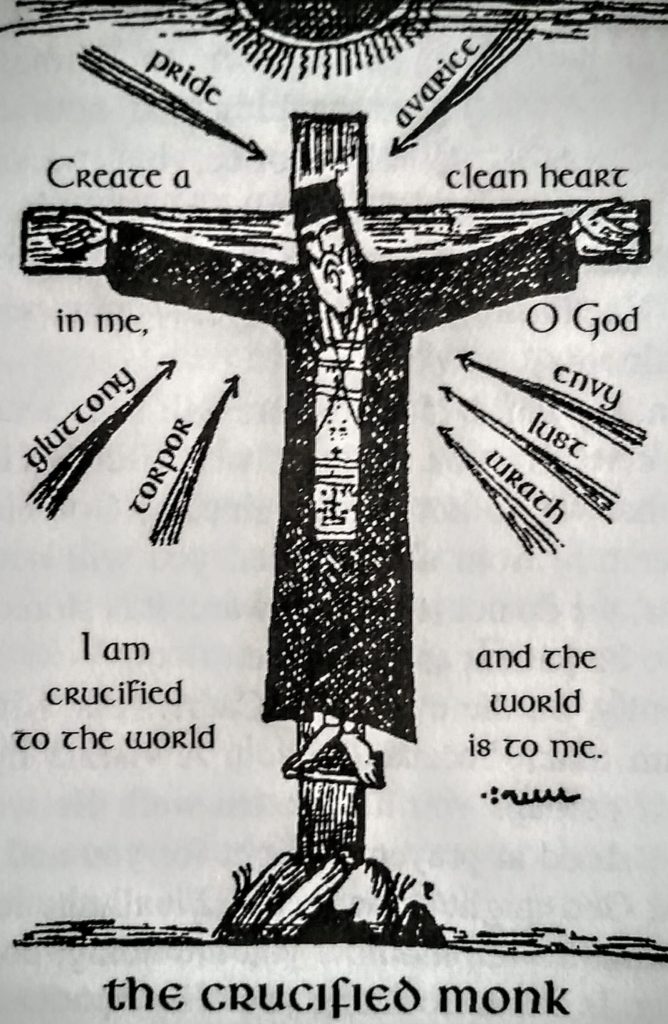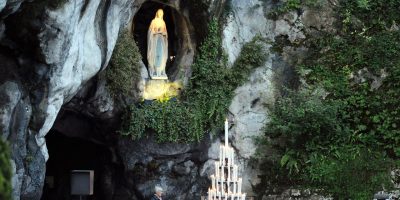Blessed Schuster’s Daily Thoughts on the Rule: Holy Tuesday
Holy Tuesday
Station at St Prisca
The Memorial of the Passion
1. The Station is on the Aventine at the Titulus Priscae, which some Authors would see in relation to Priscilla and the Pudentii of the Apostolic Age. In the Middle Ages, the house of the Pudentii gave place to a well-known Benedictine abbey.
The Gospel reading recounts the Lord’s Passion according to Saint Mark. (Mark 14:1-72; 15:1-46)
***
Saint Benedict too recommends to us frequent meditation on the Saviour’s Passion, when, at the conclusion of the Prologue to the Rule, he affirms that the entire monastic life is a patient and prolonged participation in the Passion of Christ, so as in due time to have a part in His glory.
This sharing of ours in the Passion of the Saviour is essential to the Christian life, given the fact that through Baptism complanctati facti sumus similitudinis mortis eius [sic] (Rom 6:5: ‘We have been grafted onto His death in order to relive it’): that is, we have been grafted onto the tree of His death.
We make up the mystical body of Christ for this purpose, so that He, by means of the suffering Church, may accomplish the redemption of the world.
***
2. The perpetual and daily remembrance of the Lord’s death, especially thanks to the Eucharistic Mystery, gives a new and profound significance to the words: Omni tempore vita monachi Quadragesimae debet observationem habere. (Rule, Ch. 49: ‘At every time the life of the monk should continue the Lenten observance.’) It is always Lent, as there is always in the Church a perpetual Mass. Iuge Sacrificium.[A continual sacrifice.]
Christ has ordered: ‘Do this in remembrance of Me.’ (Luke 22:19) Saint Paul in his turn commands: ‘You shall commemorate the death of the Lord until the day of His glorious return.’ (1 Cor 11:26)
Unlike the manifold and more recent devotions and practices of piety, ancient monastic devotion was traditionally concentrated around a solemn Conventual Mass, which, still today, is sung every day in the Benedictine abbeys.
We observe how Saint Gertrude drew from the daily Office her spiritual nourishment; such that the greater part of her contemplations is related to the Office and the Holy Mass of each day. The same emerges from the Revelations of the Cantrix Mechtildis [‘the chantress Mechtilde’, i.e. St Mechtilde of Hackeborn, teacher of St Gertrude—Tr.]
The first and most efficacious exercise of the Via Crucis is the Holy Mass. The Holy Mass, and especially the Conventual Mass, must truly constitute in the mind and in the conscience of the monk the supreme daily act of the dominici servitii [service of the Lord], and the primary source of his sanctification in the spirit of Saint Benedict.
Saint Paul wrote: Una enim Oblatione consummavit in sempiternum sanctificatos. (Heb 10:14: ‘With one sole Oblation He brought the holy ones to perfection.’)
This is why the ancient spirituality of the Middle Ages appeared so simple and one, compared to the later more complex methods.
***
 3. At Lourdes, Saint Bernadette noted the magnificent piety of the Most Holy Virgin in making the sign of the Cross.
3. At Lourdes, Saint Bernadette noted the magnificent piety of the Most Holy Virgin in making the sign of the Cross.
Too often mere habit guides us in signing ourselves with the Cross in the Divine Offices and at the Mass.
And yet, the example of the Saints teaches us the great efficacy of this saving Sign, which puts the demons to flight and draws down the mercies of Heaven upon the devout.
Saint Benedict traced the sign of the Cross with such efficacy that in the refectory of Vicovaro he broke the poisoned chalice simply by his blessing: Ac si pro signo lapidem dedisset. (St Gregory, Dialogues II, 3: ‘As if, instead of the sign of the Cross, he had hurled a stone.’)
At other times, he advised the monks to trace the cross on their heart in the moments of temptation. This he did, for example, with the little monk who was vain because he was son of a government official.
In memory of this devotion of the Holy Patriarch for the sign of the Cross, in the late Middle Ages there began to be spread that particular form of exorcism which, approved and indulgenced by the Roman Pontiffs, is today commonly known as St Benedict’s Cross.
The use of these blessed medals is widespread even among the Abyssinians [i.e., Ethiopians], and from it numerous graces and miracles are everywhere obtained.
